
It is probably true that a person’s environment shapes their personality. It is also probably true that this is not always a rosy topic. Many people live in an environment that is not of their choosing that perhaps builds a personality, disposition and perspective that is composed of harsh and thorny elements. They might then spend a lifetime disguising or promoting that environmental stamp in social interactions, and that too, only if it had been discovered and defined. Success in life might be measured just by overcoming these adversities and there are many fine stories of personal triumph despite the odds.
But what if it wasn’t possible to disguise or promote the effect of these influences at will? What if the creative process was so visceral that whatever impulse the environment had created was indelibly a part of it? Did Elgar’s compositions, as he looked out over the Malvern Hills find a special mix of English sound? Why was it different to the distinctly English Gloriana of Vaughan-Williams perhaps influenced by the marvelous surroundings of Down Ampney or Tanhurst. I’m certain that the influences of the Great War find their way unrelentingly into the music of so many- though the first hand horror of Ravel’s influences might have produced a different effect to the removed yet psychological ones borne by Elgar. Perhaps this is a digression, and not exactly the same as living and breathing a certain air or being a living part of a certain landscape.
 Also, this topic is not confined to music, by any means. We’re certain there is something indelibly Oxfordian in the works of C. S Lewis and J.R.R Tolkien. If one has lived in Oxford – even through the short stint of attaining a degree – the magical connections are indisputable.If George Herbert was inspired, beyond his high Anglican religious life, by the parish environment of Fugglestone and Bemerton it would be interesting to define what that might be. Catholic religious life – specifically contact with Newman, Pusey and the Oxford Movement – must have had a profound effect on Gerard Manley Hopkins, but are there other influences in the environment of Hampstead, Oxford or Dublin that informed his poetic style? And if he shared the Hampstead experience with John Keats, how does that relate to the different creative impulses between the two? In other words, which landscape inspired the words, “The world is charged with the grandeur of God”, and which bustling environment conjured the words, “And all is seared with trade; bleared, smeared with toil; and wears man’s smudge and shares man’s smell:…”?
Also, this topic is not confined to music, by any means. We’re certain there is something indelibly Oxfordian in the works of C. S Lewis and J.R.R Tolkien. If one has lived in Oxford – even through the short stint of attaining a degree – the magical connections are indisputable.If George Herbert was inspired, beyond his high Anglican religious life, by the parish environment of Fugglestone and Bemerton it would be interesting to define what that might be. Catholic religious life – specifically contact with Newman, Pusey and the Oxford Movement – must have had a profound effect on Gerard Manley Hopkins, but are there other influences in the environment of Hampstead, Oxford or Dublin that informed his poetic style? And if he shared the Hampstead experience with John Keats, how does that relate to the different creative impulses between the two? In other words, which landscape inspired the words, “The world is charged with the grandeur of God”, and which bustling environment conjured the words, “And all is seared with trade; bleared, smeared with toil; and wears man’s smudge and shares man’s smell:…”?
This throws up many more questions than answers. Why did Mahler retreat to those little composition huts, in the woods or on the lake? Is there a direct link between the view from the huts and the sound of the orchestration? I’m not referring to melodies, which might stay, circle, be old friends or come new from different inspirations. I’m trying to search for a specific sound perhaps in the woodwinds or a specific matching of orchestral colour that speaks to the atmosphere of that compositional environment. We know that Mahler’s ideas are greatly influenced by his days in Iglau – where the contradictions of a German military enclave and a Jewish Moldavian background are front and center in his early symphonies. But is there something else at the foot of Blanik Hill, or in the country side known so well to Mahler’s ancestors, that informs the actual sound?
This topic has fascinated me for a while, but now, this April found new life. I’m completing the writing of this blog from Helsinki and I’ve just visited the home of Jean Sibelius for the first time. Ainola sits a short ride from Helsinki and was the Sibelius family home for many years. It was the location for multiple compositions. I was determined to test whether I could viscerally feel the rich woodwind sounds; the deep brooding of bassoons; the low writing for the clarinet or rich harmonies in the lower strings in the environs of the house. In short, any of the Sibelius signatures, I hoped, would be present in the trees, in the air, in the Finnish landscape and especially in the house at Ainola.
There are delicious contradictions from Sibelius himself which we should be happy to grapple with. However, we also know that he gives us misleading statements, sometimes deliberately neurotic and hypochondriac – by his own admission. We must try and find some of the answers for ourselves.
“The framework of a symphony must be so strong that it forces you to follow it regardless of the environment and circumstances: [it is] an “ethical necessity”. (To Jussi Jalas, 1st October 1939)
And yet…
“Today at ten to eleven I saw 16 swans. One of my greatest experiences! God, how beautiful! They circled above me for a long time. They disappeared into the haze of the sun like a shining silver ribbon. The sounds are like a kind of woodwind, the same as the sound of the cranes, but without the tremolo. The sound of the swans is closer to the trumpet, even if it clearly recalls the timbre of the sarrusophone. A low refrain, which is like the crying of a small child. Nature mysticism and the pain of life! The finale of the fifth symphony … Ligature in the trumpets!! This had to happen to me, who has been an outsider for so long. So I’ve been in a holy place”
Well, Ainola turned out to be a mixed bag. The surroundings were of a rich backdrop of forest and there is no doubt that the house in Sibelius’s time would have provided a nutty, wooden atmosphere from where all the clarinet, bassoon and brooding sounds might come. I also could feel within the purpose built log cabin, a sense of simple, rustic order, which can also be found in the music. But this was the family home, with its joys and its tragedies. I wanted to feel more than I was able.
The curation was a bit sterile. The modern motorway, the current landscaping and the general atmosphere did not convey the sense of isolation that must have been present in 1903 at its construction, and for most of Sibelius life. I wish I could have experienced a bit of that.
I’m not sure my pictures can convey the experience, but I thought it worth the blog.
Many thanks!








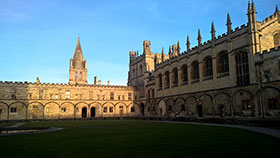
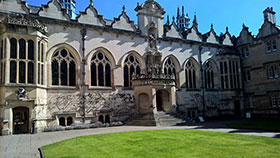
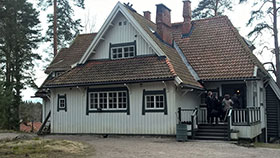
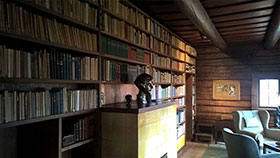
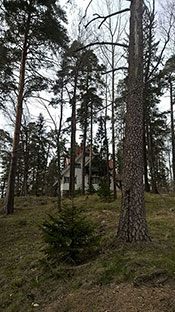
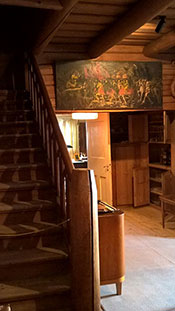
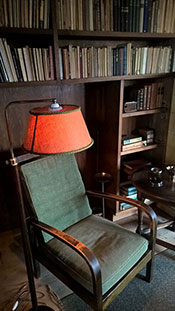
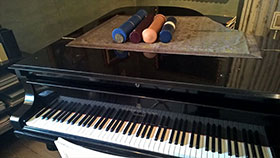
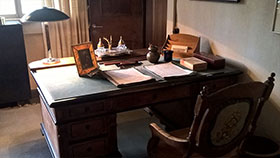
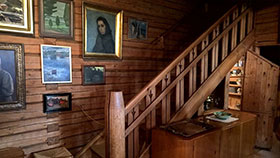
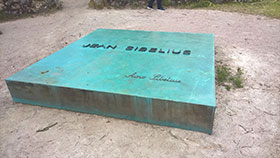
Thanks for sharing the pictures … yes, they are worth the blog!
Could it be that these composers were impelled as it were to seek solitude, to escape the clutter and clamour of a more urbane existence to be able to give expression to their inner promptings (inner truth, maybe!). On the other hand, while a person’s environment shapes his/her personality and their ‘output’it is also possible that the effect of the environment is moderated by what a person brings into it from his/her life experiences. Of course, economic compulsions or political pressure also compell the kind of work/art that is produced.
Thanks very much for the comment…glad you enjoyed the pictures…that’s the extraordinary camera on my Nokia 1520.
What I find fascinating – in most things – is when we are “scratching at the surface” for an understanding. I know that the creative process can be influenced, and influenced by things that are uncontrollable, as this blog suggests. But then, 1778, Mozart in Paris, with his dear mother who succumbed to an undiagnosed disease and died – and no notable trace of this in the glorious multiple compositions from that year, including the great ‘Paris’ Symphony. “No one knows anything”…is a great position to endorse! Z.D.